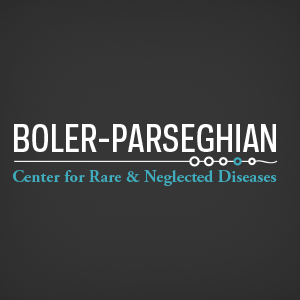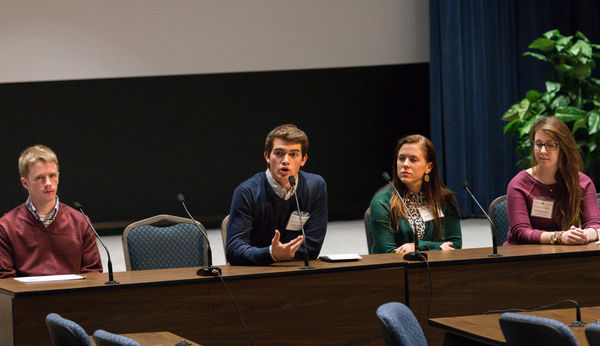

The Boler-Parseghian Center for Rare and Neglected Diseases recently held a two-day Rare Disease Symposium (February 13-14) and invited researchers, patients, families, physicians, and advocacy groups to speak about their personal experiences with rare diseases. The symposium anticipated Rare Disease Day, recognized worldwide on the last day of February.
Organized by Barbara Calhoun, nurse practitioner and outreach coordinator for the Boler-Parseghian Center, the event featured research presentations as well as discussion panels focused on patient experiences. Because there are roughly 7,000 rare diseases, diagnosis usually takes about 5-7 years and treatments are uncommon or even nonexistent. These diseases are emotionally hard to cope with, so it is important for patients and families to find others who struggle with the same illnesses for support.
Students from the RareND Club played a big part in the symposium. Many members of the club are students who have personal experience with rare diseases and those who wish to pursue careers in healthcare. The RareND Club organized a quiz, which was answered through texts from the audience, to demonstrate the difficulty in diagnosis of rare diseases.
Dr. Elizabeth Berry-Kravis, a clinician researcher at Rush University and Notre Dame alumna, spoke about her work exploring delivery of an experimental drug to patients suffering from Niemann-Pick Type C (NPC) disease, a devastating neurodegenerative disorder. Following her talk, Dr. Berry-Kravis joined families of the patients under her care in a panel, where they discussed with the audience the challenges of caring for someone with a rare disease and the hopes for a cure. In addition, Karen Quandt, a nurse, advocate and NPC mother spoke about helping clinicians better diagnose the disease.
Local pediatrician Dr. Carol Luzzi presented information on the differences she has seen in children who have rare neurological versus behavioral disorders. She focused on the nuances of diagnosis and shared patient success stories.

Other presentations and panels featured a number of Notre Dame students. Bernie Grey, alumnus ’14 and master’s candidate in mathematics, spoke about his own experience with Common Variable Immune Deficiency. Two computer science majors Dan McCormack and Bradley Stalcup discussed how they are applying their work with databases to aid in diagnosis and management of rare diseases.
Friday’s research presentations focused on current rare disease research at the university and in the community. Robert Stahelin, professor of chemistry and biochemistry, and Basar Bilgicer, professor of chemical and biomolecular engineering and professor of chemistry and biochemistry, held two in-depth discussions on Ebola, the mechanism of infection, and improvements that can be made in methods of detection.
Purdue University professor of biology, David H. Thompson explained new drug treatments for patients with Niemann-Pick Type C (NPC) disease, a fatal, degenerative disease which typically begins in childhood. As well, clinician Elizabeth Berry-Kravis, M.D. discussed her current tests with new investigational drugs to treat NPC. Berry-Kravis has seen positive results in stabilizing patients, and her work is showing promising progress. In addition, ESTEEM student Robert Power spoke about Diagnostics in Neurological Diseases, including NPC.

Shahir Rizk, the center’s director of external programs and research assistant professor of biological sciences, discussed Non-Ketotic Hyperglycinemia; Zhangali Peng, professor of mechanical and biomolecular engineering, modeled the dynamics of red blood cells in sickle cell anemia; and professor of biological sciences Jeff Schorey discussed Mycobacteria Avium, a rare infection that compromises the immune system.
The research talks, which spanned a number of genetic disorders and infections, were streamed live through the Boler-Parseghian website, so patient families from the US and Europe who could not travel were able to see the progress in rare disease research at Notre Dame.
Both days of the symposium involved student engagement. “Since last year, we have structured the event as a course for Notre Dame students interested in participating in rare disease research or advocacy. It has been a great success because it allows the students to interact directly with patients and their families. This is an extremely valuable experience for Notre Dame students who are not typically exposed to clinical research, especially those considering a career in medicine,” said Shahir Rizk.
Twenty-nine students registered for the course this year. The symposium complements the class taught by Kasturi Haldar, Rev. Julius Nieuwland, C.S.C. Professor of Biological Sciences, titled Clinical Research in Rare and Neglected Diseases, which allows students to work with real patient records, identify symptoms of rare diseases, and score the severity of disease progression. In connection with the class, a small group of computer science students are working with Barbara Calhoun to establish the Rare Health Exchange (RHE), a database of the information collected by the students.
To see more photos from the event, please visit the photo gallery. (Photos by BlueKrishna Photography).